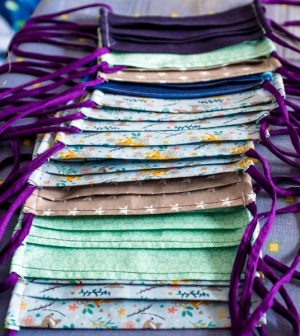- Navigating Your Midlife Crisis: Embracing New Possibilities
- City Raccoons Showing Signs of Domestication
- Mapping the Exposome: Science Broadens Focus to Environmental Disease Triggers
- One Week Less on Social Media Linked to Better Mental Health
- Your Brain Changes in Stages as You Age, Study Finds
- Some Suicide Victims Show No Typical Warning Signs, Study Finds
- ByHeart Formula Faces Lawsuits After Babies Sickened With Botulism
- Switch to Vegan Diet Could Cut Your Greenhouse Gas Emissions in Half
- Regular Bedtime Does Wonders for Blood Pressure
- Dining Alone Could Mean Worse Nutrition for Seniors
Tips to Making a Highly Effective COVID Mask at Home

When choosing a face mask to help prevent the spread of COVID-19, it seems like the choices are endless.
To make the decision a little easier, researchers at the University of British Columbia in Vancouver, Canada, tested several styles in 41 types of fabric.
The upshot: A mask made of two layers of low-thread-count quilting cotton paired with a three-ply dried baby wipe as a filter is just as effective as a commercial non-surgical mask at stopping particles. And it’s almost as breathable.
These cloth masks filtered out up to 80% of three-micron particles, and more than 90% of 10-micron particles, the study found.
“We focused on particles larger than one micron because these are likely most important to COVID-19 transmission,” said lead author Steven Rogak, a professor of mechanical engineering who studies aerosols. “While the COVID-19 virus is only around 0.1 micron in size, it is always attached to something larger, like the droplets produced by breathing, talking and coughing, which are typically in the micron and not submicron range.”
The key to a good mask, as much as composition and breathability, is fit, the study authors said.
Even the touted N95 masks are going to take in large, massive droplets with lots of viruses if they don’t seal against the face, Rogak said in a university news release.
So, a cloth mask that fits well paired with a baby-wipe filter will be more effective at filtering five- or 10-micron particles than a poorly fitted N95 mask, he said.
The highest leak rates are around the nose, chin and cheeks. Pleated-style masks tend to leak the most, Rogak said. The mask should not sit flat against the mouth and nose, but have a bigger curvature in front so the whole mask is engaged in air exchange, he explained.
World Health Organization guidelines recommend three layers for a non-medical mask: An absorbent inner layer near the mouth, a middle filtration layer and an outer layer.
The study expands on that, recommending double-knit cotton, quilting cotton, knit nylon or polyester satin for the outer layer, and double-knit cotton, quilting cotton or simple-weave silk for the layer closest to the skin.
The cotton and silk are breathable and wick away moisture, while providing efficient filtration. The nylon and polyester repel water, keeping harmful droplets from reaching inner layers. Dried baby wipes make surprisingly good filters, the researchers noted.
According to co-author Jane Wang, a clinical professor in the faculty of medicine, “Baby wipes are typically made of spunlace and spunbond polypropylene, similar to the types of polypropylene found in medical masks and N95 respirators. They are breathable and trap particles efficiently. They’re biocompatible, containing minimal preservatives and chemicals that may otherwise cause irritation or breathing problems.”
The goal of wearing a mask is reducing risk, Wang said. A mask won’t be effective if worn incorrectly or if double masking causes overheating, makes it hard to breathe or causes CO2 retention problems, she said.
The findings were recently published in the journal Aerosol Science and Technology.
More information
The U.S. Centers for Disease Control and Prevention shares more tips on masks.
SOURCE: University of British Columbia, news release, Feb. 2, 2021
Source: HealthDay
Copyright © 2025 HealthDay. All rights reserved.










